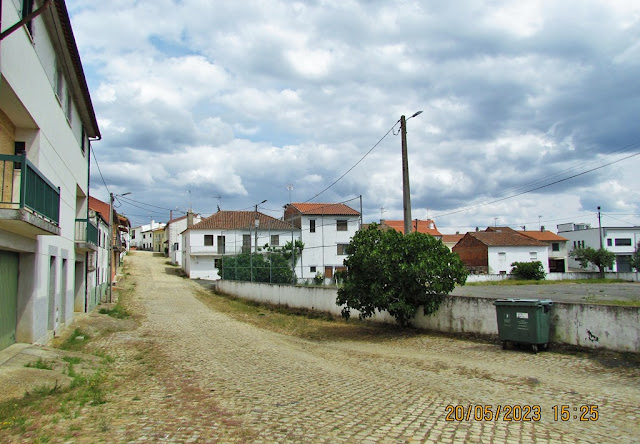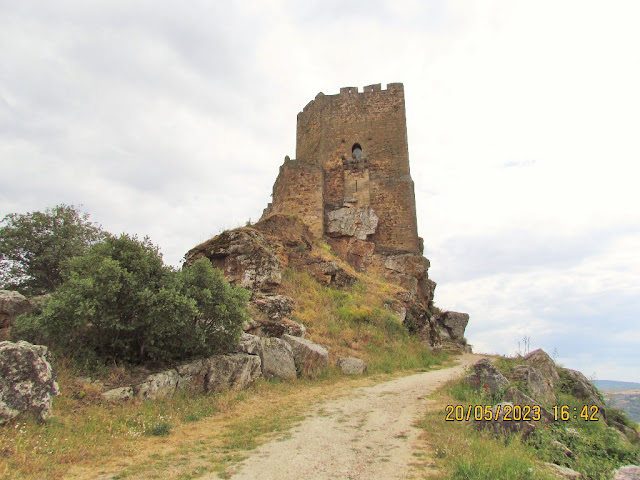ALGOSO
N 41.47065º; W 6.57550º
Algoso was a Portuguese parish in the municipality of Vimioso with an area of 37.11 km² and 281 inhabitants (2011), thus having a demographic density of 7.6 inhabitants/km².
The parish was extinguished having been integrated into the parish of Algoso, Campo de Víboras and Uva.
It constituted, with its Castle, an important possession of the Order of Malta, an ancient Religious and Military Order. That is why the coat of arms of the parish bears the cross of the said Order.
It was a town and county seat until the beginning of the 19th century. It consisted of the parishes of Atenor, Silva, Saldanha, Travanca, Urrós, Algoso, Matela, Uva, Avinho, Figueira de Algoso, Fonte Ladrão, Granja de São Pedro da Silva, Gregos, Junqueira, Mora, São Cristóvão de Malta, Teixeira, Vale Certo, Vale de Algoso and Vila Chã da Ribeira.
The Parish was composed of 2 villages:
Algoso
Algoso Valley
Patrimony:
Pelourinho of Algoso
Algoso Castle
Chapel of Our Lady of the Assumption
Chapel of Saint John
Chapel of Sao Roque
Church of the Mercy of Algoso
Church of Algoso (Saint Sebastian Church)
Algoso Bridge
CASTLE OF ALGOSO
N 41.46263º; W 6.57930
The Castle of Algoso (Portuguese: Castelo de Algoso) is a medieval castle in the civil parish of Algoso, Campo de Víboras e Uva, municipality of Vimioso, in the Portuguese district of Bragança. The castle of Algoso is one of the most important medieval fortifications in the eastern Trás-os-montes, related to the battles of Leonese succession, the tentative policies of the independent Portuguese monarch, and the important religious commandery of the Knights Hospitaller that established their roots in 1224.
The castles of Bragança, Outeiro (Bragança), Castle of Algoso and Castle of Miranda do Douro, supported by the small fortresses of Vimioso and Penas Roias, formed the northwest defensive line of the Kingdom of Portugal with the Kingdom of León, which in 1493 the king John II of Portugal called the “corregimento das fortresses of Trallos Montes”.
In a dominant position over the top of Penenciada, it dominates the surrounding plain and the confluence of the Angueira and the Maçãs rivers. In the region of North Region, Portugal, from the top of its walls, you can see Serra da Sanábria, Serra de Bornes, and of Serra da Nogueira. It has a 360-degree view of the Mirandese plateau, located at an altitude of 690 meters, next to the Angueira River.
History
Archaeological excavations permit conclusions associated with an early settlement before the Middle Ages, there existed a castle on the current site, that supported various settlements, identified with the Chalcolithic period (that include Bronze Age molds), proto-historic and Roman (such as the discovery of ceramics associated with a period of non-military settlement).
Medieval
During the Christian Reconquista, the primitive frontier of the County of Portugal with the Kingdom of León extended along the left bank of the Sabor River, to its confluence with the Angueira River. This link was watched by various sentinel outposts: the Castle of Milhão, the Castle of Santulhão (both today long disappeared), the Castle of Outeiro de Miranda (in ruins), and in the eastern edge, the Castle of Algoso. The remainder of the principal defense occurred in the northwest, across the protector of the Castles of Penas Róias, Mogadouro, and Bragança.
Sometime during the 12th century, D. Mendo Rufino (or Bofino), master of the lands of "Ulgoso" by donation of D. Afonso Henriques, ordered the construction of a fortress, in order to watch and guard the frontier with the Kingdom of León.[1][4] From information during the 1258 Inquirições, Mendo Rufino (who was one of the supporters of Afonso Henriques against D. Teresa) constructed the castle in exchange for the village of Vimioso.[1], where he died and whose majorat was taken over by his son Afonso Mendes. The Majorat of Algoso was assumed by his son Rodrigo Mendes, who as established in the document assumed the family name Rodrigues de Algoso and as established in the document assumed the Lordship of Algoso, later Count.
During this period of uncertainty that is the transition between Afonso Henriques reign as the first Portuguese monarch, and the exercise of regal power by Sancho I, the castle became an important link with loyal nobility, which had ties to the King of León but harbored loyalties with the Portuguese. As the "head" of the Terra da Miranda, Algoso was an important fortress; a "nuclear point of support with the regal authority" in this peripheric region.
Unfortunately, little remains of the early construction, although it is assumed that the castle was built on the Romanesque principles of the time, which included a keep tower surrounded by a walled fortification and battlements. Yet, little remains to suggest that was the case since no archaeological surveys are related to this period, and that many of the 12th-century fragments may have been swept away by events in the subsequent years. Between the 12th and 13th centuries, the alcaide offered the castle to King D. Sancho I, who compensated his captain, by offering him the title of master of Vimioso, which was conferred on Mendo Rufino. The King planned of transforming Algoso into the center of his vast territory, encompassing the area of Miranda do Douro and Penas Róias. But, between 1212 and 1213, the lands were invaded by troops loyal to the King of León, Alfonso IX, as a reprisal for the contestation of the Portuguese King against the donations to his sisters. Following a period of turmoil, in 1219, peace was brokered between the Kingdoms of León and Portugal.
In April 1224, the primitive structure was radically altered. That year (or just before it) the castle was donated by King Sancho II to the Knights Hospitaller, after a long period of war with the Kingdom of León. At that time, the expansion of regal authority in the Trás-os-Montes Province privileged the creation of new towns, of an urban character, and relegating the existing castles into defensive military structures that expressed regal authority in the lands of Miranda and Pena Roias. The castle with "all its terms and belongings" were extended, therefore, to prior D. Rui Pais and his "successors, brother monks". The town and municipality of Ylgoso, Ulgoso ou São Sebastião de Algoso, was part of the bishopric and district of Bragança.
In 1230, the Knights Templar and the Knights Hospitaller came to a concordat in Coimbra, over various lands held between them, including Ylgoso (Algoso), Vila Chã, Atenor, Penas Róias, Paradela, and others, outside the bishopric of Bragança. On 22 June 1239, D. Pedro Costem, commander of the Order of the Temple established his commandery of Mogadouro and Pena Roias, which included Algoso. But, later, on 13 February 1291, King D. Dinis (1279-1325) reestablished in Coimbra, that D. Fernão Peres (o Mossejo), would hold the commandery of Algoso and other lands within its range. These changes had an effect on the annual rents paid by their commander: between 7000 and 8000 cruzados, including products from the abbeys of Travanca, Sendim, Vilar Seco, Duas Igrejas, and Guide. The castle, therefore, became a focus of a primitive church, dedicated to Nossa Senhora da Assunção(Our Lady of the Assumption), but became known as Our Lady of the Castle by peasantry and gentry.
In the hands of the Hospitaller monks, the castle was transformed into a Gothic fortress, characterized by an active defense policy. During this period the heptagonal keep tower was constructed, in order to better resist attacks and provide a more adequate availability of angles to inflict damage on aggressors. This included vertical attacks, with the existence of machicolations over the entranceway that served as the residence of the commander.
During the 1258 Inquirições, the castle was referenced as in a donation to the Knights Hospitaller, by the name of D. Afonso Henriques or D. Sancho II.
The commander of the Order, Father Pedro Lourenço, in 1291, appeared in a dispute between the King (then D. Dinis) and the Knights Hospitaller; in this dispute, the Knights Hospitaller and Command of Ulgoso were united in their afront of the King, and included the villages of Serapicos, Vila Chã da Beira, Uva, Mora, Saldanha, Sendim, Picote, Vilar Seco, Vinhão and couples of Cerceo.
Seven years later, D. Dinis ordered the reconstruction of the fortress.
In August 1341, a sentence from King D. Afonso IV informed that, in that year, Father D. Álvaro Gonçalves Pereira was the "Prior of Hospital in his kingdoms, that he pertained to the Castle of Ulgoso with its term since time immemorial".
In 1480, King D. Afonso V signed a foral (charter) for the settlement, which was later conceded by King D. Manuel I in 1510.[4] By 1530, the castle included cisterns and residences, but only the alcaide resided in the building.
During the Portuguese succession crisis of 1580, Diogo Fernandes de Almeida (the alcaide of the castle) took sides with the António, Prior of Crato. On his accession to the throne of Portugal, Philip I favored and conceded privileges on the municipality of Algoso (1 January 1592), putting the castle authority and noble's allegiance into question. In 1588, though, Friar Gonçalo de Azevedo, a Knight Hospitaller, and son of Diogo Almeida, was nominated by King Philip I, to act as alcaide and commander at the castle. But, this period of interrupted authority would have an effect on the importance of the fortification. It is unclear of the state of the fortifications during the intervening years, such that by the 17th century, the castle was already abandoned, and the settlement of Algoso took on a larger role in regional authority. On 22 June 1684, the archive of the commandery of Algoso included a description of the furniture and state of conservation of the castle, but the structures were abandoned and in a state of ruin.
By 1684, there were many military structures abandoned or ruined within the kingdom. At the end of the Seven Years' War, following the sack of Miranda do Douro in 1762, the Spanish plundered many of the villages and buildings of Vimioso. Garrisoned by a small contingent, under the command of an ensign, the town of Algoso resisted Spanish troops. Much later, the military government was exercised by a captain, sergeant, and four ordenanças captains. During that time, between 1689 and 1690, the municipality of Vimioso attempted work to consolidate and restore the structure.
The last occupation by military forces occurred in 1710, during the War of Spanish Succession.
During the Peninsular War, the judge of Algoso, Jacinto de Oliveira Castelo Branco, refused to accept French sovereignty and, even after the Transfer of the Portuguese Court to Brazil, following the French declaration of the extinction of the Bragança Dynasty, continued to use the titles of privilege conferred on his family. By the middle of the 19th century, Algoso was integrated into the municipality of Vimioso (1855).
💓💓💓💓💓
VALE DE ALGOSO
N 41.49728º; W 6.54047
Vale de Algoso is a small village characterized by its stone houses with typical balconies.
Its permanent population is about 30 people. Due to Rural Tourism, some houses have been rebuilt and on weekends its population can double.
Peace and quiet reign in this village.
Very close you can find a river beach with tables under the trees, grills and a support structure.
FLUVIAL BEACH
N 41.49290º; W 6.52565º
















































































































































































































































































